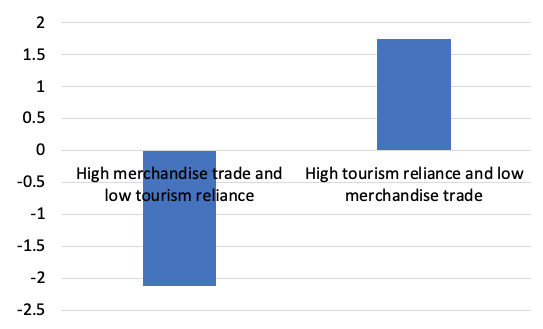Editor’s note: The paper behind this column appears in the 8th issue of CEPR’s new initiative, Covid Economics: Vetted and Real-Time Papers
Governments around the world have responded with unprecedented measures to the spread of the COVID-19. Borders are now closed for travel among most major economies. Drastic policies have been introduced to curtail economic and social activity. The early evidence so far suggests that they have indeed helped to limit the spread of the virus (e.g. Hartl et al. 2020), but at the same time there are likely to be dire economic consequences (e.g. Koren and Peto 2020, Lewis et al. 2020).
While COVID-19 is a global pandemic, the policy responses so far have been almost exclusively national. Across Europe, one country after the other closed its borders and introduced increasingly stringent domestic containment policies, culminating in lockdowns in most countries. Similarly, in the US, most of the public health response has been on the local or state level, with little coordination or policy action on the federal level. It takes little if any academic or scientific knowledge to realise that non-coordinated responses are not optimal.
In a recent paper we analyse national containment policies in an integrated world (Beck and Wagner 2020). Specifically, we consider a theoretical model with two countries that independently choose their containment policies. We provide suggestive empirical evidence that containment policies in the lockdown stage vary with their economic structure and, more specifically, the nature of economic integration with the rest of the world. Critically, we show that while during the containment phase countries might implement policies that are too stringent or too loose, during the phase of loosening these restrictions, countries will tend to adopt policies that are too loose.
National decisions with global externalities
We consider two stages of the pandemic: a lockdown stage with an initially severe spread of the virus and closed borders (as we have seen in Europe and large parts of the world over the past month or so); and a new normal stage where the virus is fairly contained (but still alive and kicking!) and borders have been reopened. The two stages interact because containment policies in the first period affect the initial (pandemic) conditions in the second stage, and through this potentially optimal policies and welfare.
In the short term, during the lockdown stage, governments face a trade-off between maintaining economic activity and the costs of a rapidly spreading virus. Critically, there are also cross-border externalities to this decision. Specifically, a lockdown and the shutdown of manufacturing companies will affect supply chains and cause disruption in the production in other countries.1 We have seen evidence of this when China shut down large parts of its economy, with negative repercussions on many companies in the US and Europe that depended on Chinese suppliers. There are also demand externalities from these containment policies as well as negative earnings effects through foreign direct investment channels. These externalities would imply that national policies in this first stage might be too stringent, as individual governments will ignore these cross-border ramifications of their actions.
There are off-setting effects, though. Countries that rely a lot on tourism, for example, might be less willing to adopt stringent containment policies and might rather be on the side of waiting rather than acting too quickly.
Some empirical evidence
To gauge whether the economic structure of a country indeed determines its approach to containment policies, we relate containment policies across 27 European countries to death rates and their reliance on merchandise trade and tourism. Countries relying more on merchandise trade ‘produce’ externalities for other countries and thus opt for rather more stringent lockdown policies, while countries relying more on tourism will delay lockdown as much as possible.
To test these hypotheses, we use data on the geographic distribution of COVID-related deaths from the European Centre for Disease Prevention and Control to identify the date when, in each of the 27 countries, the COVID-19 death toll reached or passed ten deaths. We use data from a database put together by Olivier Lejeune2 on containment policies across the globe to identify the date when non-essential shops, restaurants and bars closed, as this is a measure that most European countries have now taken (some countries have gone even further). We calculate the number of days between the date of ten or more COVID-related deaths and this containment measure, which ranges between -20 (Bulgaria) to 12 (Italy). Lower numbers indicate a quicker adoption of containment policies. As countries were hit by the virus at different points in time, thus allowing for learning effects, we first regress this difference on the date of ten or more COVID-related deaths and find a significant and negative relationship – i.e. countries that experienced a later outbreak imposed containment policies more quickly. We then compare the residuals from this crisis across four groups of countries: countries with above and below median merchandise trade to GDP, and countries with above and below international tourism receipts as share of exports (data from the World Development Indicators and for 2018).
Figure 1 Variation in containment policies
Figure 1 provides suggestive evidence consistent with our model. Countries with above median merchandise exports were quicker in imposing containment policies, not taking into account externalities on other countries through supply chains or demand externalities. Countries with above median reliance on tourism, on the other hand, were slower in imposing containment policies. When considering the two groups of countries in the two extremes of our two variables high (low) merchandise trade and low (high) reliance on tourism the difference is even stronger.
Containment under the new normal
Decisions taken during the first (lockdown) stage affect the starting position and thus policies during the second stage (the new normal). The more successful the suppression of the virus has been, the lower the costs of the virus during the new normal stage of our model. Further, in the new normal phase, externalities will be predominantly coming through the cross-border spreading of the virus rather than economic channels. We assume that at this stage borders are open, allowing people to travel internationally.3 Direct disruptions in the production process from curtailing production in the other country are thought to be of less relevance then, because production processes will have adjusted; firms will have modified their supply chain and countries will have become more autarkic.
This implies that during the new normal, containment policies may be excessively lenient, and particularly so in countries that have a high mobility (inward and outward), such as popular tourist destinations.
Policy conclusions
There are several policy conclusions. First, the first-best solution is global coordination on public health responses, including domestic containment policies. Second, in the absence of being able to coordinate on the global level, regional coordination is called for. There are already examples for this: the European Commission is trying to coordinate exit strategies towards the new normal among member states; in the US, five governors of Atlantic states (Connecticut, Massachusetts, New York, New Jersey, Rhode Island, Delaware and Pennsylvania) have agreed to coordinate their exit strategies. Our model suggests that such coordination can be helpful in avoiding too lenient exit strategies and in achieving optimal policies in minimising the costs of COVID-19.
References
Beck, T and W Wagner (2020), “National containment policies and international cooperation”, Covid Economics, Vetted and Real-Time Papers 8, 22 April.
Eichenbaum, M, S Rebelo and M Trabandt (2020), “The Macroeconomics of Epidemics”, NBER Working Paper No. 26882
Hartl, T, K Waelde and E Weber (2020), “Measuring the impact of the German public shutdown on the spread of COVID-19”, Covid Economics, Vetted and Real-Time Papers 1, 5 April.
Inoue, H and T Todo (2020), “The propagation of the economic impact through supply chains: The case of a mega-city lockdown to contain the spread of COVID-19”, Covid Economics, Vetted and Real-Time Papers 8, 22 April.
Koren, M and R Peto (2020), “Business disruptions from social distancing”, Covid Economics, Vetted and Real-Time Papers 2, 8 April.
Lewis, D, K Mertens and J Stock (2020), “US economic activity during the early weeks of the SARS-Cov-2 outbreak”, Covid Economics, Vetted and Real-Time Papers 6, 17 April.
Endnotes
1 For an analysis of domestic spill-overs through supply chain, see Inoue and Todo (2020) on the effect of the lock-down in Tokyo on the Japanese economy. Eichenbaum et al. (2020) model the domestic macroeconomic implications of the pandemic, stressing that economic activities create (negative) health externalities through interactions, in the production or consumption process.
2 https://github.com/OlivierLej/Coronavirus_CounterMeasures
3 Austria is at this moment considering opening their borders for tourism this summer, but only vis-à-vis countries where the virus is well under control.





